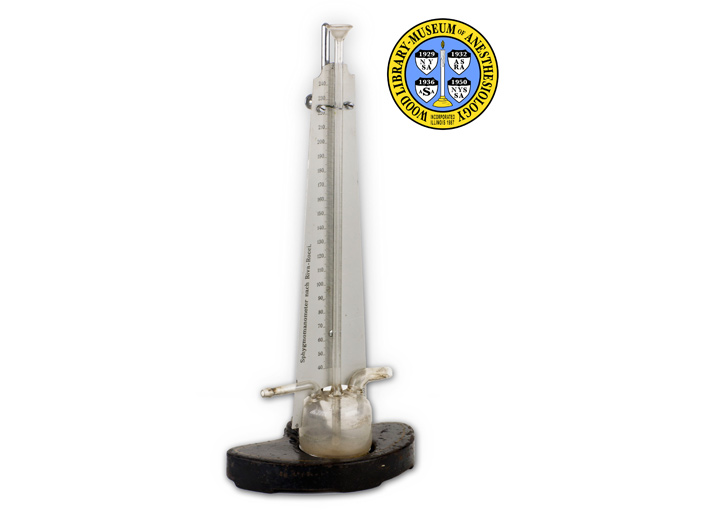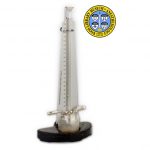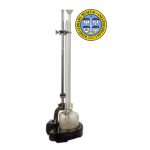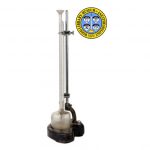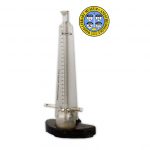Riva-Rocci Sphygmomanometer
Scipione Riva-Rocci (1863-1937) was an Italian internist and pediatrician. Before he introduced his mercury-sphygmomanometer in 1896, obtaining a patient’s blood-pressure was, at best, very difficult. The word sphygmomanometer is Greek and means 'pulse pressure meter.' Riva-Rocci's method involved several steps to obtain the systolic blood-pressure. A rubber cuff covered with a thin cloth was wrapped around the patient’s arm. The physician would feel for the patient’s pulse in the wrist (called the "radial pulse"), and then inflate the cuff with a rubber bulb. The cuff was inflated until the radial pulse could not be felt. Pressure in the cuff was measured by the height of the mercury in the sphygmomanometer’s vertical glass tube. Then the physician would slowly release the pressure in the cuff while watching the level of the mercury to note at which line the radial pulse could again be felt – This was the systolic pressure. Although the process to obtain a patient’s blood-pressure has changed, mercury-based instruments for measuring blood-pressure have changed very little from Riva-Rocci’s original design.
Dr. Harvey Cushing (1869-1939), an American neurosurgeon, was an early advocate of patient monitoring during anesthesia and surgery, and an early adopter of the Riva-Rocci Sphygmomanometer. Although many other tools have been developed to allow anesthesiologists to monitor the status of a patient’s heart and circulatory, or blood transportation, system, blood-pressure remains an essential component of evaluating a patient’s condition throughout the surgical process.
Donated in honor of WLM Assistant Librarian Teresa Jimenez, MSLIS, by WLM Honorary Curator George Bause MD.
Catalog Record: Riva-Rocci Sphygmomanometer
Access Key: aiuh
Accession No.: 2010-09-09-1
Title: Sphygmomanometer nach Riva-Rocci / [designed by Scipione Riva-Rocci].
Author: Riva-Rocci, Scipione, 1863-1937.
Title variation: Alt Title
Title: Riva-Rocci sphygmomanometer.
Title variation: Alt Title
Title: Riva-Rocci machine.
Title variation: Alt Title
Title: Riva-Rocci’s sphygmomanometer.
Publisher: [S.l.] : R.K.u. Co., [1896-1930].
Physical Description: 1 sphygmomanometer : cast iron, glass, other metals (steel?, chrome or nickel plating?), paint ; 32 x 15 x 9.5 cm.
Subject: Sphygmomanometers.
Subject: Blood Pressure Determination – instrumentation.
Subject: Blood Pressure Monitors.
Note Type: General
Notes: Title from manufacturer markings on the device.
Note Type: Citation
Notes: Booth J. A short history of blood pressure measurement. Proc R Soc Med.
1977;70(11):793-799.
Note Type: Citation
Notes: Gardner WJ. Neurosurgery. In: Brown KL, ed. Medicine in Cleveland and
Cuyahoga County: 1810-1976. Cleveland, Ohio: Academy of Medicine of Cleveland
1977:494-495.
Note Type: Citation
Notes: Shevchenko YL, Tsitlik JE. 90th Anniversary of the development by Nikolai S.
Korotkoff of the auscultatory method of measuring blood pressure. Circulation
1996;94(2):116-118.
Note Type: Physical Description
Notes: A mercury sphygmomanometer with a cast-iron base, approx. 2.2 x 15 x 9.5 cm
in size; A cylindrical reservoir, approx. 4 x 6 cm dia, of clear glass sits
on top of the center of the cast-iron base; The reservoir has two tubular
connections, or ports, that protrude from the top of the reservoir: one from
the left side and one from the right ;The glass ‘port’ on the left, for the
tubing to the inflating-bulb, exits the reservoir about .5 cm vertically and
then bends 90 degrees to extend approx. 4.5 cm to the left; The ‘port’ the
right, for the tubing to the blood-pressure-cuff, exits the reservoir about 1
cm vertically and the bends 90 degrees to extend approx. 3.5 cm to the right;
Rising 26 cm above the center of the top of the reservoir is a clear glass
tube approx 6 mm in dia.; Behind the vertical-tube is a thin sheet of medal,
approx. 26 cm high, 6.5 cm wide at the bottom, 2.5 cm at the top, and only a
mm thick; The sheet of metal is painted grey with black markings, including
graduation marks in the center; Each mark designates a mm of Mercury (mmHg);
Numbers mark the graduations along the left side of the vertical tube from 40
to 240 (although the marks extend to 250); A number “0”, located at the very
bottom left and right sides of the sheet of metal, marks 0 mmHg; Manufacturer
markings also on the sheet of metal include, “Sphygmomanometer nach
Riva-Rocci” running vertically along the far-left side, and “R.K.u.Co.” on
the far lower right, just above the right “0” mark; Behind the sheet of metal
is a metal post approx. 29.5 cm high; The post is secured to the cast-iron
base and supports the sheet of metal and the vertical tube.
Note Type: Reproduction
Notes: Photographed by Mr. William Lyle in the Fall of 2010.
Note Type: Acquisition
Notes: Donated to the WLM by George S. Bause, M.D. WLM Honorary Curator, in honor of
Teresa Jimenez, MS LIS.
Note Type: Historical
Notes: Instruments to measure blood-pressure have a long history, but before
Scipione Riva-Rocci, an Italian internist and pediatrician, introduced his
mercury-sphygmomanometer in 1896 they were, at best, difficult to use.
Riva-Rocci’s method allowed physicians to easily obtain a person’s systolic
blood-pressure. The cuff was wrapped around the arm and inflated by the use
of a rubber bulb (Booth, 1977). His ‘cuff’ was a 5 cm wide rubber bag, inside
a thin textile cover. The pressure of the cuff was measured by the height of
the mercury in the vertical glass tube. The cuff was inflated until the
radial pulse could not be felt. While pressure in the cuff was slowly
released, the physician watched the sphygmomanometer and noted at what mmHg
the radial pulse could again be felt – This was the systolic pressure (Booth,
1977). Since 1896, mercury-based instruments for measuring blood-pressure
have changed very little. In 1901 Heinrich von Recklinghausen, a German
physician, discovered that the cuff needed to be larger, and in 1905 Nikolai
S. Korotkoff, a Russian physician, reported his method of obtaining both the
systolic and diastolic blood-pressures by using a stethoscope to listen over
the brachial artery for sounds indicating those pressures (Booth, 1977 ;
Shevchenko & Tsitlik, 1996). Mercury-sphygmomanometers have been used for
over a century, but because of safety concerns with mercury, and the advent
of affordable and reliable digital devices, the day when
mercury-sphygmomanometers can no longer be found in the clinical setting may
by very near.
Note Type: Historical
Notes: Two American surgeons who were early advocates of patient monitoring during
anesthesia and surgery, Dr. George Crile (1864-1943) and Dr. Harvey Cushing
(1869-1939), were early adopters of the Riva-Rocci Sphygmomanometer (Gardner,
1977).


